Managing Operations: Enhancing Customer Value Report, 2019
VerifiedAdded on 2019/10/09
|9
|2261
|237
Report
AI Summary
This report, prepared for the Managing Operations and the Supply Chain module (BSOM046) at the University of Northampton, examines the multifaceted concept of customer value. It begins by defining customer value and then delves into a comprehensive literature review, exploring its relationship with key concepts such as quality management, supply chain management, operations management, cost, customer service, and logistics lead time. The report analyzes the relevance of value creation for the customer in modern operations management, supported by examples from the trade press and authoritative sources. Furthermore, it critically evaluates Kotler's perspective on customer value, offering an operations management perspective. The report adheres to the Harvard Referencing System and is structured according to the provided checklist, encompassing definitions, literature reviews, and critical reflections. The assignment aims to demonstrate an understanding of value creation, its enhancement, and its impact on customer retention and economic sustainability within an operational context.
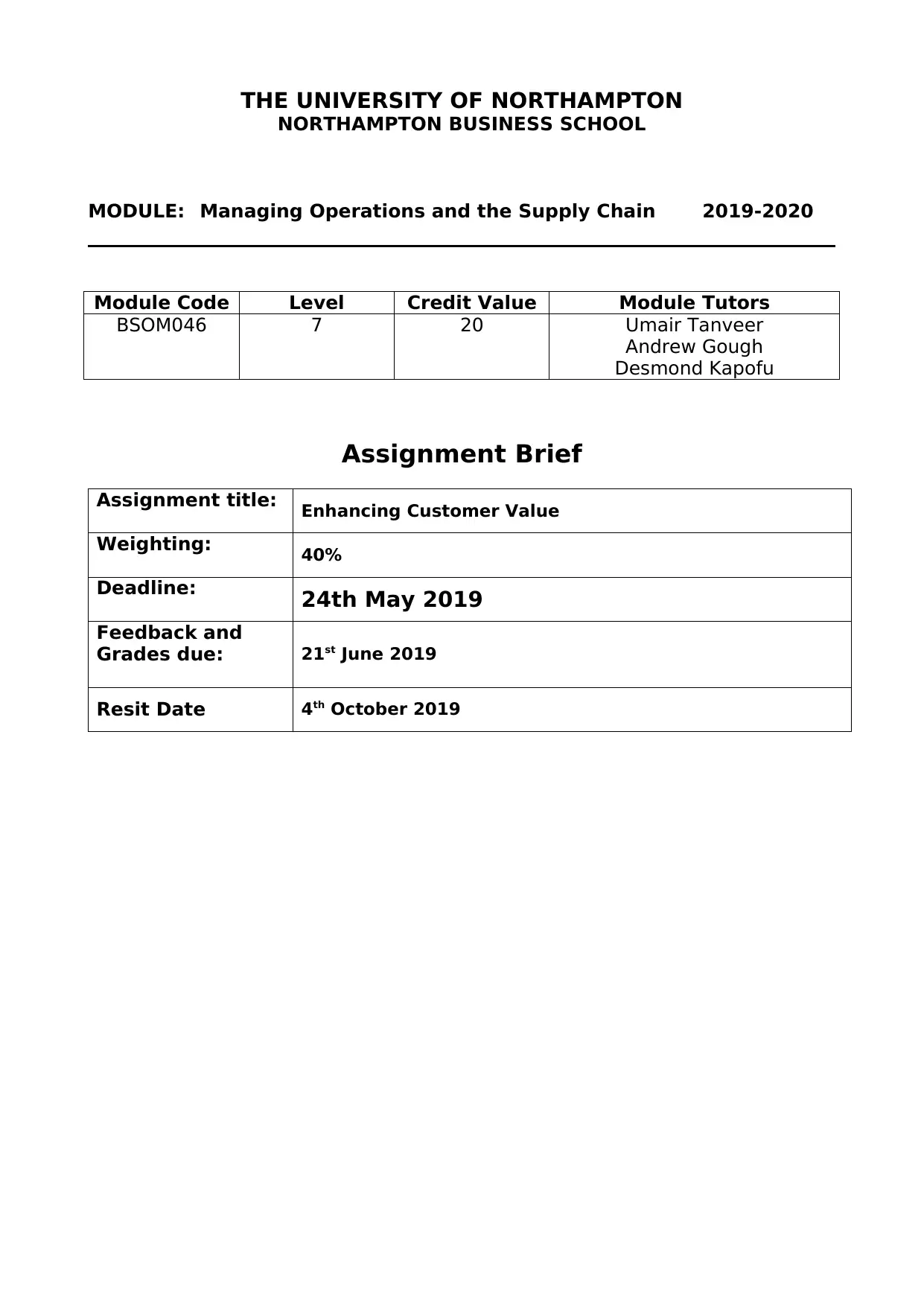
THE UNIVERSITY OF NORTHAMPTON
NORTHAMPTON BUSINESS SCHOOL
MODULE: Managing Operations and the Supply Chain 2019-2020
Module Code Level Credit Value Module Tutors
BSOM046 7 20 Umair Tanveer
Andrew Gough
Desmond Kapofu
Assignment Brief
Assignment title: Enhancing Customer Value
Weighting: 40%
Deadline: 24th May 2019
Feedback and
Grades due: 21st June 2019
Resit Date 4th October 2019
NORTHAMPTON BUSINESS SCHOOL
MODULE: Managing Operations and the Supply Chain 2019-2020
Module Code Level Credit Value Module Tutors
BSOM046 7 20 Umair Tanveer
Andrew Gough
Desmond Kapofu
Assignment Brief
Assignment title: Enhancing Customer Value
Weighting: 40%
Deadline: 24th May 2019
Feedback and
Grades due: 21st June 2019
Resit Date 4th October 2019
Paraphrase This Document
Need a fresh take? Get an instant paraphrase of this document with our AI Paraphraser
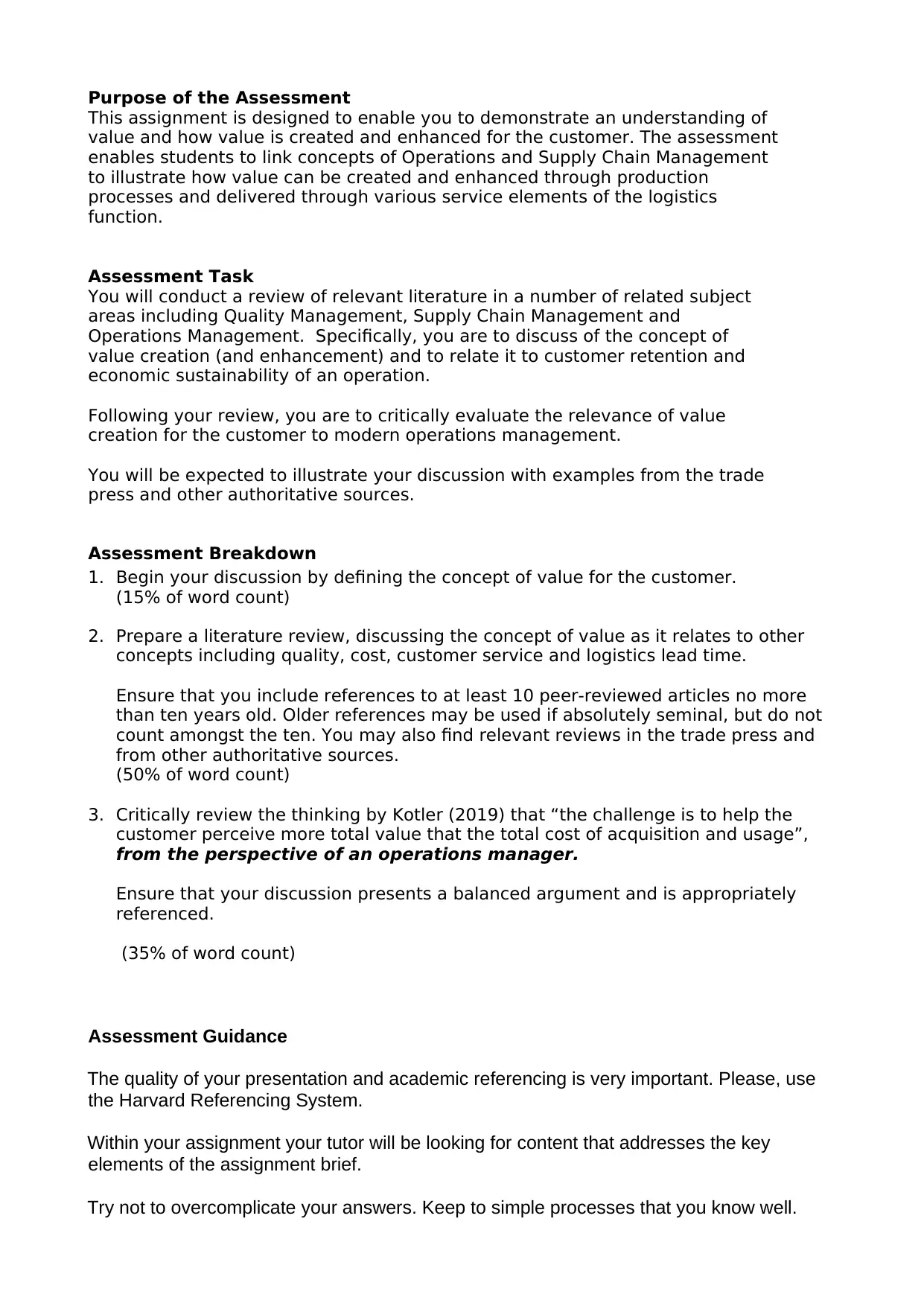
Purpose of the Assessment
This assignment is designed to enable you to demonstrate an understanding of
value and how value is created and enhanced for the customer. The assessment
enables students to link concepts of Operations and Supply Chain Management
to illustrate how value can be created and enhanced through production
processes and delivered through various service elements of the logistics
function.
Assessment Task
You will conduct a review of relevant literature in a number of related subject
areas including Quality Management, Supply Chain Management and
Operations Management. Specifically, you are to discuss of the concept of
value creation (and enhancement) and to relate it to customer retention and
economic sustainability of an operation.
Following your review, you are to critically evaluate the relevance of value
creation for the customer to modern operations management.
You will be expected to illustrate your discussion with examples from the trade
press and other authoritative sources.
Assessment Breakdown
1. Begin your discussion by defining the concept of value for the customer.
(15% of word count)
2. Prepare a literature review, discussing the concept of value as it relates to other
concepts including quality, cost, customer service and logistics lead time.
Ensure that you include references to at least 10 peer-reviewed articles no more
than ten years old. Older references may be used if absolutely seminal, but do not
count amongst the ten. You may also find relevant reviews in the trade press and
from other authoritative sources.
(50% of word count)
3. Critically review the thinking by Kotler (2019) that “the challenge is to help the
customer perceive more total value that the total cost of acquisition and usage”,
from the perspective of an operations manager.
Ensure that your discussion presents a balanced argument and is appropriately
referenced.
(35% of word count)
Assessment Guidance
The quality of your presentation and academic referencing is very important. Please, use
the Harvard Referencing System.
Within your assignment your tutor will be looking for content that addresses the key
elements of the assignment brief.
Try not to overcomplicate your answers. Keep to simple processes that you know well.
This assignment is designed to enable you to demonstrate an understanding of
value and how value is created and enhanced for the customer. The assessment
enables students to link concepts of Operations and Supply Chain Management
to illustrate how value can be created and enhanced through production
processes and delivered through various service elements of the logistics
function.
Assessment Task
You will conduct a review of relevant literature in a number of related subject
areas including Quality Management, Supply Chain Management and
Operations Management. Specifically, you are to discuss of the concept of
value creation (and enhancement) and to relate it to customer retention and
economic sustainability of an operation.
Following your review, you are to critically evaluate the relevance of value
creation for the customer to modern operations management.
You will be expected to illustrate your discussion with examples from the trade
press and other authoritative sources.
Assessment Breakdown
1. Begin your discussion by defining the concept of value for the customer.
(15% of word count)
2. Prepare a literature review, discussing the concept of value as it relates to other
concepts including quality, cost, customer service and logistics lead time.
Ensure that you include references to at least 10 peer-reviewed articles no more
than ten years old. Older references may be used if absolutely seminal, but do not
count amongst the ten. You may also find relevant reviews in the trade press and
from other authoritative sources.
(50% of word count)
3. Critically review the thinking by Kotler (2019) that “the challenge is to help the
customer perceive more total value that the total cost of acquisition and usage”,
from the perspective of an operations manager.
Ensure that your discussion presents a balanced argument and is appropriately
referenced.
(35% of word count)
Assessment Guidance
The quality of your presentation and academic referencing is very important. Please, use
the Harvard Referencing System.
Within your assignment your tutor will be looking for content that addresses the key
elements of the assignment brief.
Try not to overcomplicate your answers. Keep to simple processes that you know well.

Look at the Check list at the end of this brief. It shows the subheadings to use and offers a
guide as to how the marks will be distributed.
Use the percentages as a guide to how to distribute your word count.
Academic Practice
This is an individual assignment. The University of Northampton policy will apply in all
cases of copying, plagiarism or any other methods by which students have obtained (or
attempted to obtain) an unfair advantage.
Support and guidance on assessments and academic integrity can be found from the
following resources
Assessment Submission
To submit your work, please go to the ‘Submit your work’ area on the NILE site and use
the relevant submission point to upload your report. The deadline for this is 11.59pm (UK
local time) on the date of submission.
Written work submitted to TURNITIN will be subject to anti-plagiarism detection software.
Turnitin checks student work for possible textual matches against internet available
resources and its own proprietary database.
When you upload your work correctly to TURNITIN you will receive a receipt which is your
record and proof of submission.
If your assignment is not submitted to TURNITIN rather than a receipt you will see a green
banner at the top of the screen that denotes successful submission.
Your assignment must be word processed and presented in a report format with simple
sub-headings. The word count should be 1600 words ±10% (tables, diagrams and
appendices are excluded from the count).
The Assignment report should have a Front Sheet showing your name, your student
number, the module name, the module number, the assignment title, the module tutor's
name, the date and the word count
N.B Work emailed directly to your tutor will not normally be marked. The only
exception to this is when you are instructed to do so because TURNITIN is down.
Late submission of work
For first sits, if an item of assessment is submitted late and an extension has not been
granted, the following will apply:
Within one week of the original deadline – work will be marked and returned with full
feedback and awarded a maximum bare pass grade.
More than one week from original deadline – maximum grade achievable LG (L
indicating late).
At the second opportunity deadline (resits) work submitted late will be awarded a LG
grade. There is no opportunity to submit work late for a bare pass.
Extensions
guide as to how the marks will be distributed.
Use the percentages as a guide to how to distribute your word count.
Academic Practice
This is an individual assignment. The University of Northampton policy will apply in all
cases of copying, plagiarism or any other methods by which students have obtained (or
attempted to obtain) an unfair advantage.
Support and guidance on assessments and academic integrity can be found from the
following resources
Assessment Submission
To submit your work, please go to the ‘Submit your work’ area on the NILE site and use
the relevant submission point to upload your report. The deadline for this is 11.59pm (UK
local time) on the date of submission.
Written work submitted to TURNITIN will be subject to anti-plagiarism detection software.
Turnitin checks student work for possible textual matches against internet available
resources and its own proprietary database.
When you upload your work correctly to TURNITIN you will receive a receipt which is your
record and proof of submission.
If your assignment is not submitted to TURNITIN rather than a receipt you will see a green
banner at the top of the screen that denotes successful submission.
Your assignment must be word processed and presented in a report format with simple
sub-headings. The word count should be 1600 words ±10% (tables, diagrams and
appendices are excluded from the count).
The Assignment report should have a Front Sheet showing your name, your student
number, the module name, the module number, the assignment title, the module tutor's
name, the date and the word count
N.B Work emailed directly to your tutor will not normally be marked. The only
exception to this is when you are instructed to do so because TURNITIN is down.
Late submission of work
For first sits, if an item of assessment is submitted late and an extension has not been
granted, the following will apply:
Within one week of the original deadline – work will be marked and returned with full
feedback and awarded a maximum bare pass grade.
More than one week from original deadline – maximum grade achievable LG (L
indicating late).
At the second opportunity deadline (resits) work submitted late will be awarded a LG
grade. There is no opportunity to submit work late for a bare pass.
Extensions
⊘ This is a preview!⊘
Do you want full access?
Subscribe today to unlock all pages.

Trusted by 1+ million students worldwide
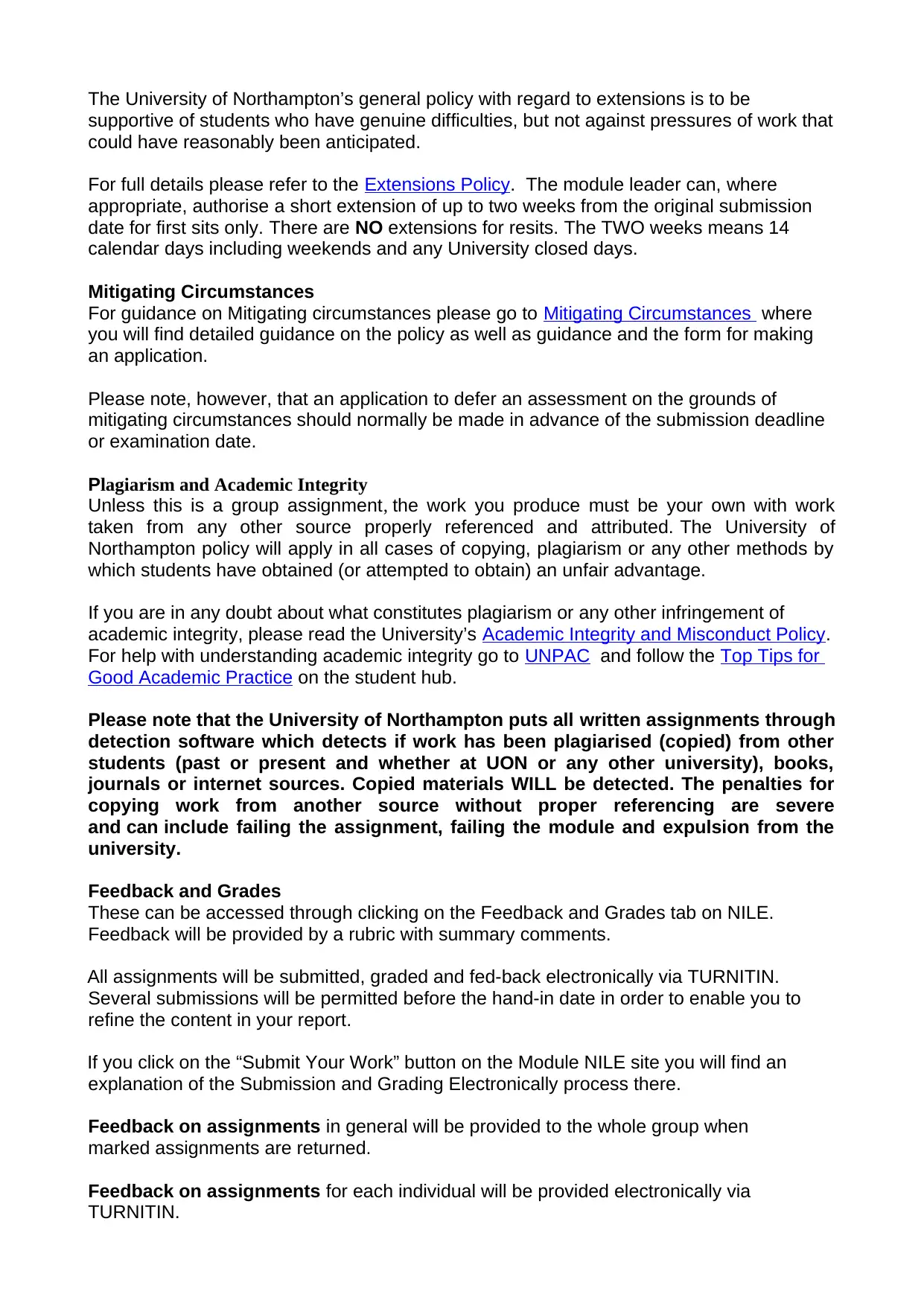
The University of Northampton’s general policy with regard to extensions is to be
supportive of students who have genuine difficulties, but not against pressures of work that
could have reasonably been anticipated.
For full details please refer to the Extensions Policy. The module leader can, where
appropriate, authorise a short extension of up to two weeks from the original submission
date for first sits only. There are NO extensions for resits. The TWO weeks means 14
calendar days including weekends and any University closed days.
Mitigating Circumstances
For guidance on Mitigating circumstances please go to Mitigating Circumstances where
you will find detailed guidance on the policy as well as guidance and the form for making
an application.
Please note, however, that an application to defer an assessment on the grounds of
mitigating circumstances should normally be made in advance of the submission deadline
or examination date.
Plagiarism and Academic Integrity
Unless this is a group assignment, the work you produce must be your own with work
taken from any other source properly referenced and attributed. The University of
Northampton policy will apply in all cases of copying, plagiarism or any other methods by
which students have obtained (or attempted to obtain) an unfair advantage.
If you are in any doubt about what constitutes plagiarism or any other infringement of
academic integrity, please read the University’s Academic Integrity and Misconduct Policy.
For help with understanding academic integrity go to UNPAC and follow the Top Tips for
Good Academic Practice on the student hub.
Please note that the University of Northampton puts all written assignments through
detection software which detects if work has been plagiarised (copied) from other
students (past or present and whether at UON or any other university), books,
journals or internet sources. Copied materials WILL be detected. The penalties for
copying work from another source without proper referencing are severe
and can include failing the assignment, failing the module and expulsion from the
university.
Feedback and Grades
These can be accessed through clicking on the Feedback and Grades tab on NILE.
Feedback will be provided by a rubric with summary comments.
All assignments will be submitted, graded and fed-back electronically via TURNITIN.
Several submissions will be permitted before the hand-in date in order to enable you to
refine the content in your report.
If you click on the “Submit Your Work” button on the Module NILE site you will find an
explanation of the Submission and Grading Electronically process there.
Feedback on assignments in general will be provided to the whole group when
marked assignments are returned.
Feedback on assignments for each individual will be provided electronically via
TURNITIN.
supportive of students who have genuine difficulties, but not against pressures of work that
could have reasonably been anticipated.
For full details please refer to the Extensions Policy. The module leader can, where
appropriate, authorise a short extension of up to two weeks from the original submission
date for first sits only. There are NO extensions for resits. The TWO weeks means 14
calendar days including weekends and any University closed days.
Mitigating Circumstances
For guidance on Mitigating circumstances please go to Mitigating Circumstances where
you will find detailed guidance on the policy as well as guidance and the form for making
an application.
Please note, however, that an application to defer an assessment on the grounds of
mitigating circumstances should normally be made in advance of the submission deadline
or examination date.
Plagiarism and Academic Integrity
Unless this is a group assignment, the work you produce must be your own with work
taken from any other source properly referenced and attributed. The University of
Northampton policy will apply in all cases of copying, plagiarism or any other methods by
which students have obtained (or attempted to obtain) an unfair advantage.
If you are in any doubt about what constitutes plagiarism or any other infringement of
academic integrity, please read the University’s Academic Integrity and Misconduct Policy.
For help with understanding academic integrity go to UNPAC and follow the Top Tips for
Good Academic Practice on the student hub.
Please note that the University of Northampton puts all written assignments through
detection software which detects if work has been plagiarised (copied) from other
students (past or present and whether at UON or any other university), books,
journals or internet sources. Copied materials WILL be detected. The penalties for
copying work from another source without proper referencing are severe
and can include failing the assignment, failing the module and expulsion from the
university.
Feedback and Grades
These can be accessed through clicking on the Feedback and Grades tab on NILE.
Feedback will be provided by a rubric with summary comments.
All assignments will be submitted, graded and fed-back electronically via TURNITIN.
Several submissions will be permitted before the hand-in date in order to enable you to
refine the content in your report.
If you click on the “Submit Your Work” button on the Module NILE site you will find an
explanation of the Submission and Grading Electronically process there.
Feedback on assignments in general will be provided to the whole group when
marked assignments are returned.
Feedback on assignments for each individual will be provided electronically via
TURNITIN.
Paraphrase This Document
Need a fresh take? Get an instant paraphrase of this document with our AI Paraphraser

A student may obtain an individual appointment to discuss feedback with the tutor.
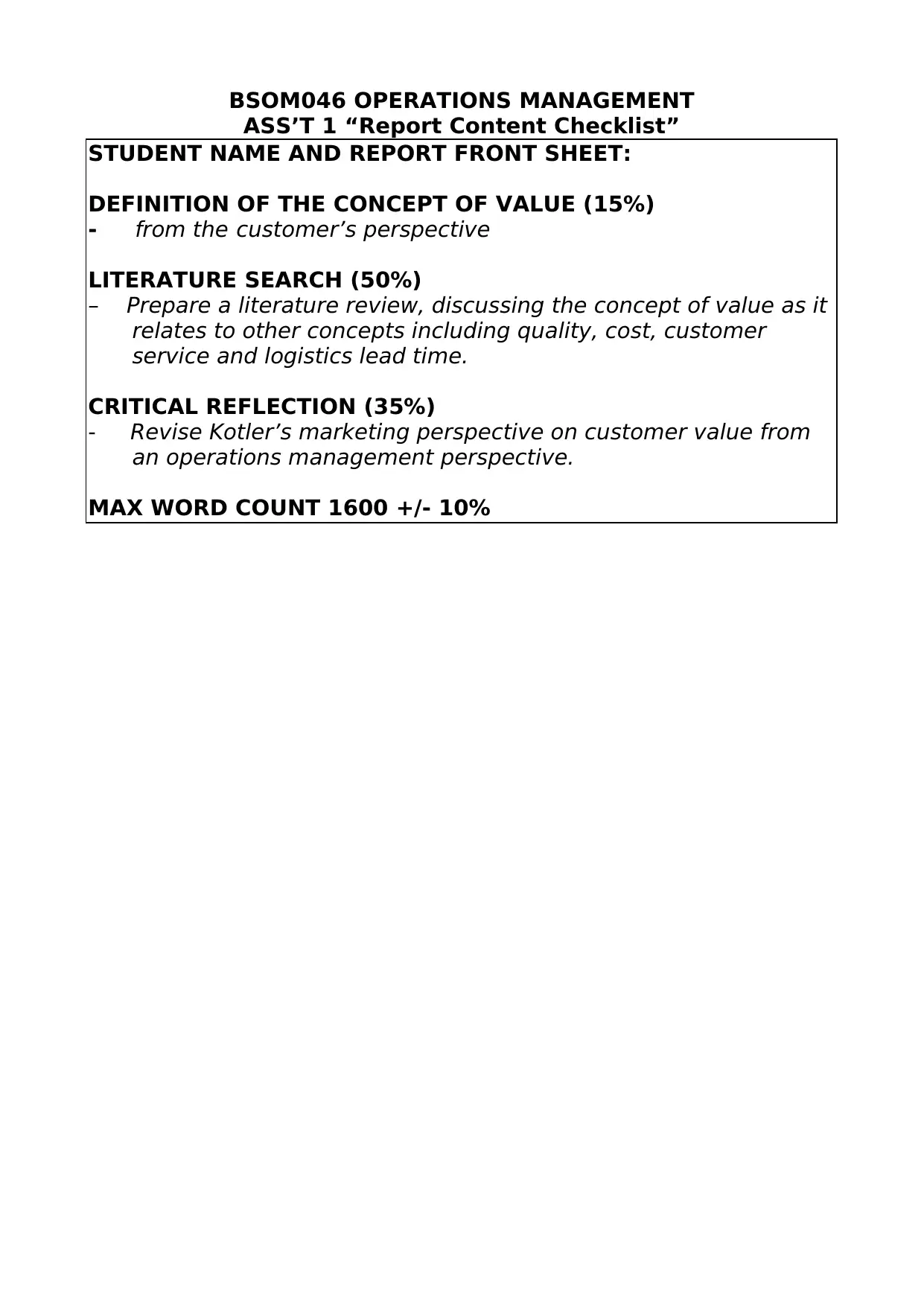
BSOM046 OPERATIONS MANAGEMENT
ASS’T 1 “Report Content Checklist”
STUDENT NAME AND REPORT FRONT SHEET:
DEFINITION OF THE CONCEPT OF VALUE (15%)
- from the customer’s perspective
LITERATURE SEARCH (50%)
– Prepare a literature review, discussing the concept of value as it
relates to other concepts including quality, cost, customer
service and logistics lead time.
CRITICAL REFLECTION (35%)
- Revise Kotler’s marketing perspective on customer value from
an operations management perspective.
MAX WORD COUNT 1600 +/- 10%
ASS’T 1 “Report Content Checklist”
STUDENT NAME AND REPORT FRONT SHEET:
DEFINITION OF THE CONCEPT OF VALUE (15%)
- from the customer’s perspective
LITERATURE SEARCH (50%)
– Prepare a literature review, discussing the concept of value as it
relates to other concepts including quality, cost, customer
service and logistics lead time.
CRITICAL REFLECTION (35%)
- Revise Kotler’s marketing perspective on customer value from
an operations management perspective.
MAX WORD COUNT 1600 +/- 10%
⊘ This is a preview!⊘
Do you want full access?
Subscribe today to unlock all pages.

Trusted by 1+ million students worldwide
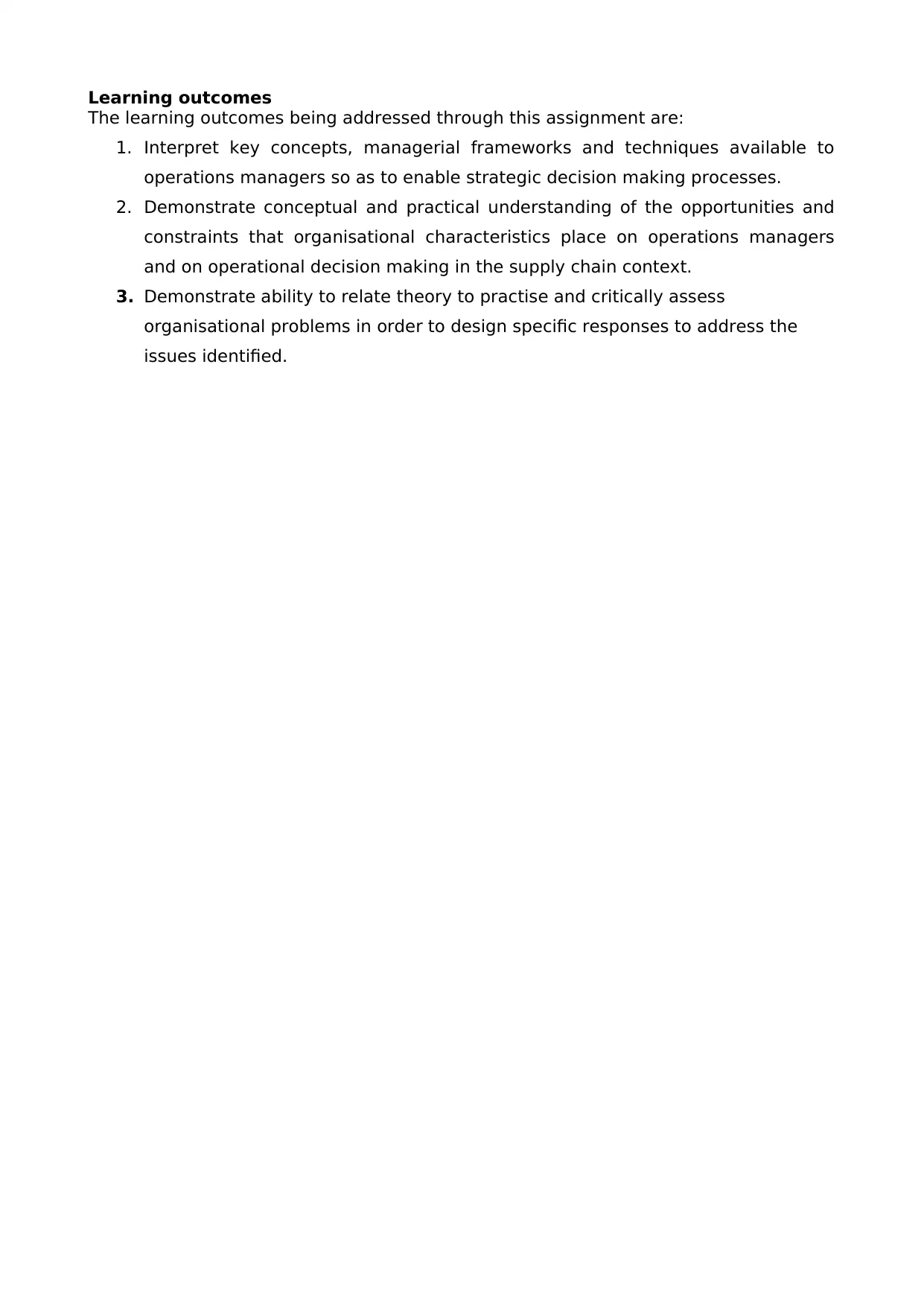
Learning outcomes
The learning outcomes being addressed through this assignment are:
1. Interpret key concepts, managerial frameworks and techniques available to
operations managers so as to enable strategic decision making processes.
2. Demonstrate conceptual and practical understanding of the opportunities and
constraints that organisational characteristics place on operations managers
and on operational decision making in the supply chain context.
3. Demonstrate ability to relate theory to practise and critically assess
organisational problems in order to design specific responses to address the
issues identified.
The learning outcomes being addressed through this assignment are:
1. Interpret key concepts, managerial frameworks and techniques available to
operations managers so as to enable strategic decision making processes.
2. Demonstrate conceptual and practical understanding of the opportunities and
constraints that organisational characteristics place on operations managers
and on operational decision making in the supply chain context.
3. Demonstrate ability to relate theory to practise and critically assess
organisational problems in order to design specific responses to address the
issues identified.
Paraphrase This Document
Need a fresh take? Get an instant paraphrase of this document with our AI Paraphraser
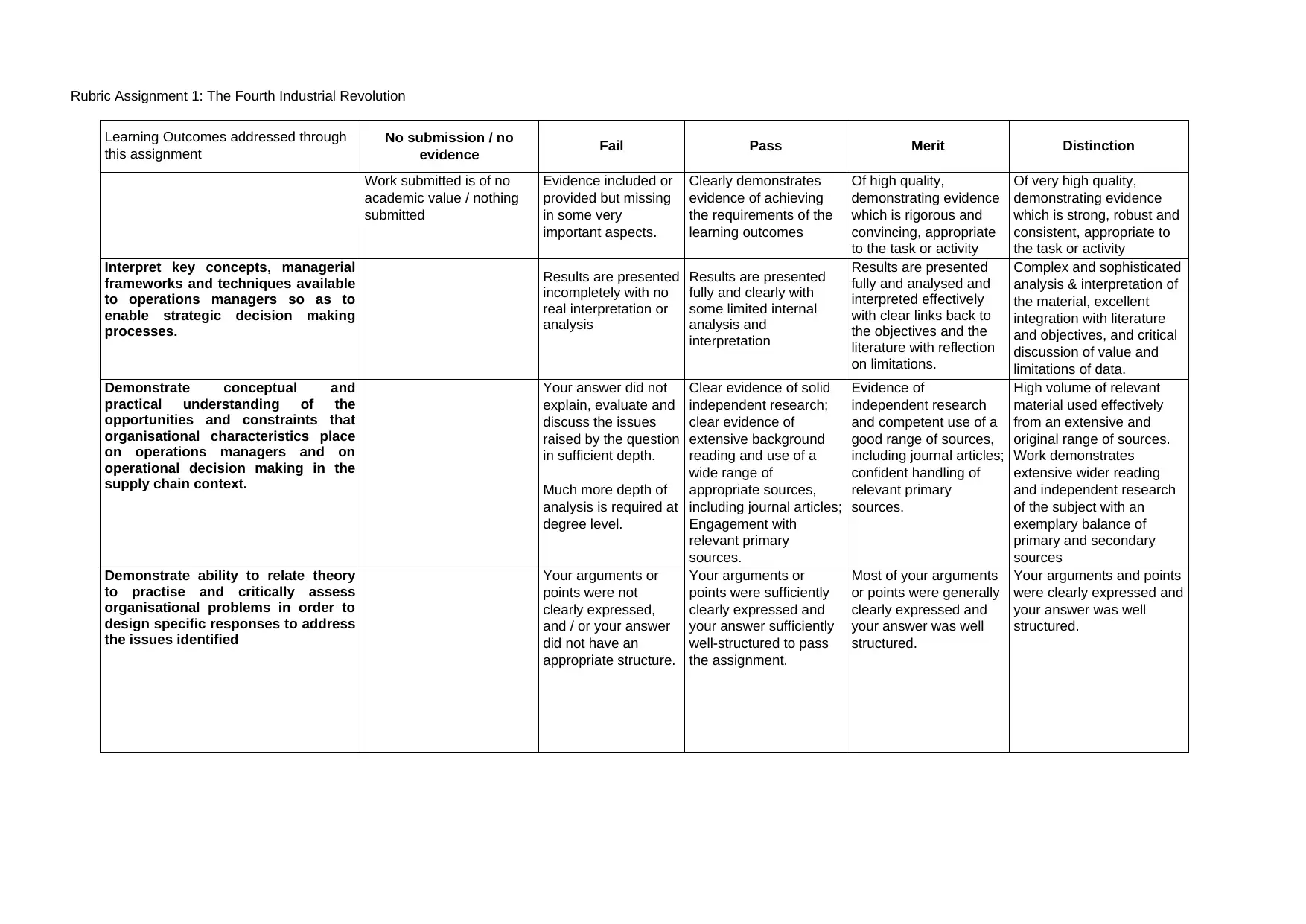
Rubric Assignment 1: The Fourth Industrial Revolution
Learning Outcomes addressed through
this assignment
No submission / no
evidence Fail Pass Merit Distinction
Work submitted is of no
academic value / nothing
submitted
Evidence included or
provided but missing
in some very
important aspects.
Clearly demonstrates
evidence of achieving
the requirements of the
learning outcomes
Of high quality,
demonstrating evidence
which is rigorous and
convincing, appropriate
to the task or activity
Of very high quality,
demonstrating evidence
which is strong, robust and
consistent, appropriate to
the task or activity
Interpret key concepts, managerial
frameworks and techniques available
to operations managers so as to
enable strategic decision making
processes.
Results are presented
incompletely with no
real interpretation or
analysis
Results are presented
fully and clearly with
some limited internal
analysis and
interpretation
Results are presented
fully and analysed and
interpreted effectively
with clear links back to
the objectives and the
literature with reflection
on limitations.
Complex and sophisticated
analysis & interpretation of
the material, excellent
integration with literature
and objectives, and critical
discussion of value and
limitations of data.
Demonstrate conceptual and
practical understanding of the
opportunities and constraints that
organisational characteristics place
on operations managers and on
operational decision making in the
supply chain context.
Your answer did not
explain, evaluate and
discuss the issues
raised by the question
in sufficient depth.
Much more depth of
analysis is required at
degree level.
Clear evidence of solid
independent research;
clear evidence of
extensive background
reading and use of a
wide range of
appropriate sources,
including journal articles;
Engagement with
relevant primary
sources.
Evidence of
independent research
and competent use of a
good range of sources,
including journal articles;
confident handling of
relevant primary
sources.
High volume of relevant
material used effectively
from an extensive and
original range of sources.
Work demonstrates
extensive wider reading
and independent research
of the subject with an
exemplary balance of
primary and secondary
sources
Demonstrate ability to relate theory
to practise and critically assess
organisational problems in order to
design specific responses to address
the issues identified
Your arguments or
points were not
clearly expressed,
and / or your answer
did not have an
appropriate structure.
Your arguments or
points were sufficiently
clearly expressed and
your answer sufficiently
well-structured to pass
the assignment.
Most of your arguments
or points were generally
clearly expressed and
your answer was well
structured.
Your arguments and points
were clearly expressed and
your answer was well
structured.
Learning Outcomes addressed through
this assignment
No submission / no
evidence Fail Pass Merit Distinction
Work submitted is of no
academic value / nothing
submitted
Evidence included or
provided but missing
in some very
important aspects.
Clearly demonstrates
evidence of achieving
the requirements of the
learning outcomes
Of high quality,
demonstrating evidence
which is rigorous and
convincing, appropriate
to the task or activity
Of very high quality,
demonstrating evidence
which is strong, robust and
consistent, appropriate to
the task or activity
Interpret key concepts, managerial
frameworks and techniques available
to operations managers so as to
enable strategic decision making
processes.
Results are presented
incompletely with no
real interpretation or
analysis
Results are presented
fully and clearly with
some limited internal
analysis and
interpretation
Results are presented
fully and analysed and
interpreted effectively
with clear links back to
the objectives and the
literature with reflection
on limitations.
Complex and sophisticated
analysis & interpretation of
the material, excellent
integration with literature
and objectives, and critical
discussion of value and
limitations of data.
Demonstrate conceptual and
practical understanding of the
opportunities and constraints that
organisational characteristics place
on operations managers and on
operational decision making in the
supply chain context.
Your answer did not
explain, evaluate and
discuss the issues
raised by the question
in sufficient depth.
Much more depth of
analysis is required at
degree level.
Clear evidence of solid
independent research;
clear evidence of
extensive background
reading and use of a
wide range of
appropriate sources,
including journal articles;
Engagement with
relevant primary
sources.
Evidence of
independent research
and competent use of a
good range of sources,
including journal articles;
confident handling of
relevant primary
sources.
High volume of relevant
material used effectively
from an extensive and
original range of sources.
Work demonstrates
extensive wider reading
and independent research
of the subject with an
exemplary balance of
primary and secondary
sources
Demonstrate ability to relate theory
to practise and critically assess
organisational problems in order to
design specific responses to address
the issues identified
Your arguments or
points were not
clearly expressed,
and / or your answer
did not have an
appropriate structure.
Your arguments or
points were sufficiently
clearly expressed and
your answer sufficiently
well-structured to pass
the assignment.
Most of your arguments
or points were generally
clearly expressed and
your answer was well
structured.
Your arguments and points
were clearly expressed and
your answer was well
structured.

Academic / Professional quality
Poor command of
academic /
professional
conventions
appropriate to the
discipline.
Sound command of
academic / professional
conventions sufficient
and appropriate to the
discipline
Rigorous command of
academic /
professional
conventions
appropriate to the
discipline.
Authoritative
command of academic /
professional conventions
appropriate to the
discipline.
Poor command of
academic /
professional
conventions
appropriate to the
discipline.
Sound command of
academic / professional
conventions sufficient
and appropriate to the
discipline
Rigorous command of
academic /
professional
conventions
appropriate to the
discipline.
Authoritative
command of academic /
professional conventions
appropriate to the
discipline.
⊘ This is a preview!⊘
Do you want full access?
Subscribe today to unlock all pages.

Trusted by 1+ million students worldwide
1 out of 9
Related Documents
Your All-in-One AI-Powered Toolkit for Academic Success.
+13062052269
info@desklib.com
Available 24*7 on WhatsApp / Email
![[object Object]](/_next/static/media/star-bottom.7253800d.svg)
Unlock your academic potential
Copyright © 2020–2025 A2Z Services. All Rights Reserved. Developed and managed by ZUCOL.





